1. Introduction
As global health awareness continues to grow, fitness has increasingly become a vital part of modern urban lifestyles. The traditional fitness sector is limited by venue availability, time constraints, and a lack of interactivity, which makes it hard to cater to users' varied and fragmented exercise needs. The advancement of Internet technology has propelled the fitness industry online, and consequently, the O2O business model, known for its convenience and interactive features, has become central to market expansion, business innovation, and sustainable growth within the industry.
Someone believes that with the development of online operations, the "digitalisation" of fitness courses has a positive impact on the expansion of user numbers and user groups [1]. Zhang Qian argues that current sports apps are still targeted at individual users, and functions such as "appointment running" seem to cross spatial limitations but are actually "going far away", and their user experience is difficult to compare with face-to-face offline interaction [2]. Meanwhile, related research indicates that the O2O model combined with the fitness industry can enhance user interaction and community operation, increase user stickiness and retention rate, and increase corporate revenue through diversified revenue models such as membership services, content payment and brand peripheral products [3,4]. Current academic research has mostly focused on O2O business models and user behaviour [4]. Some studies have begun to focus on the development models and user value creation of Internet fitness platforms, but there is still a lack of systematic empirical analysis [5].
This paper will take Keep Fitness, which has typical O2O business model attributes in China's fitness industry, as an example to study whether the O2O model has a positive impact on the new mechanism of innovative development of commercial fitness enterprises through literature review, questionnaire survey and data analysis. It aims to reveal how user value synergy, technology empowerment and platform ecosystem evolution drive business model innovation on Internet fitness platforms, providing references for industry enterprises to optimise user operations and business models. The study enriches theories related to O2O business model innovation and provides practical references for fitness platforms to enhance user value and business value.
2. Research subjects and methods
2.1. O2O business model and the development status of keep fitness
The O2O (Online to Offline) model refers to directing online traffic through an Internet platform to offline scenarios for service delivery, which has the advantages of reducing transaction costs, expanding user coverage and enhancing user experience [5,6]. The O2O marketing model is mainly divided into two categories. One is that consumers experience offline and purchase products online [7]. This approach enables consumers to have a better understanding of product quality, service, etc. The second is offline marketing and online trading for consumers [8]. In addition to showcasing their products online, businesses can also actively develop long-term users offline, such as guiding them to sign up as members [8].
Keep Fitness is China's leading online fitness platform. Founded in October 2014, Keep topped the App Store's health and fitness chart for several consecutive days after its launch in February 2015 [8]. In August 2017, Keep had more than 100 million users. The Keep software, in the form of "Internet + sports", combined with mobile devices and made good use of the O2O model to build a fitness ecosystem [8]. In recent years, the user base and market penetration rate of Keep Fitness have continued to grow, and core indicators such as daily active users (DAU), user retention rate and paid membership penetration rate have remained at a high level, making it a representative enterprise in China's Internet fitness industry [8].
2.2. Research methods
This paper will conduct descriptive statistics and correlation analysis of user operation and enterprise revenue performance under the O2O model based on the data from Keep's annual report, performance report and questionnaire survey through literature review, questionnaire survey and data analysis.
3. Analysis of the operating mechanism of keep fitness
As a typical representative of the service industry, the core of the fitness industry's business development lies in user operations [9]. Good user operation not only enhances user experience and stickiness, but also promotes continuous conversion of users, thereby directly driving revenue growth for enterprises [10,11]. In recent years, the research and practice of Internet fitness platforms at home and abroad in user operation have mainly focused on four aspects. First, grasping the characteristics of user composition through precise profiling. The second is to analyse users' fitness habits and spending power. Third, identify users' deep-seated needs and provide personalised services. Fourth, enhance user stickiness and loyalty through community and interaction mechanisms [11]. These elements interact to form a complete chain of user operation. Based on this, this study will combine questionnaires and data analysis to systematically analyse the current status and effectiveness of Keep's user operations from five dimensions: user composition, user situation, user needs, user intention, and user stickiness.
3.1. User operation analysis
According to the survey data, Keep's user base is mainly composed of young white-collar workers and students aged 18-35, with an average exercise frequency of 2-3 times a week. This group is characterised by strong personalised demands, abundant energy, a strong desire to explore, a willingness to try new things, and a certain purchasing power [12]. At the same time, due to their limited time and energy, this group of people have a strong willingness to consume online fitness and a strong need for community participation(Figure 1). Therefore, in its online product design and user operation, it keeps focusing on user experience, such as "private customisation", personalised needs, ranking comparison, intelligent exploration, etc., to increase the frequency of user usage [12].
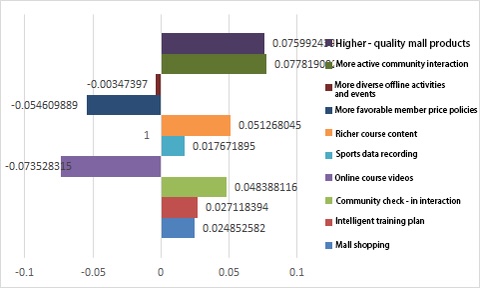
The increase in usage frequency will have a more direct impact on membership conversion rate and user penetration rate, indicating that usage frequency has a positive effect on enhancing user stickiness(Figure 2). At the same time, it was found through the questionnaire data that user satisfaction was significantly positively correlated with usage frequency (Table 1). That is, as Keep Fitness continues to optimise and balance its products and services with emphasis on user experience, it has further enhanced user satisfaction, enabling users to use the app more frequently or become its loyal members(Figure 3), thereby ensuring Keep's high intensity of user stickiness and user penetration [13].
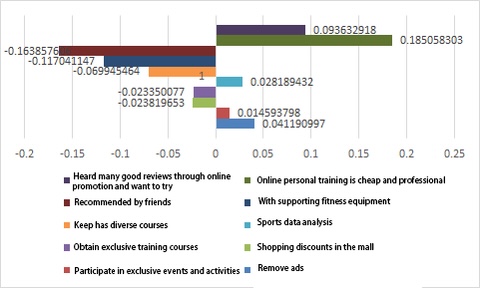
|
Variable relationships |
Pearson correlation coefficient (r) |
Significance level (p) |
Sample size (n) |
|
Frequency of use and user satisfaction |
0.63 |
< 0.01 |
182 |
Note: p < 0.01 indicates a significant correlation at the 99% confidence level.
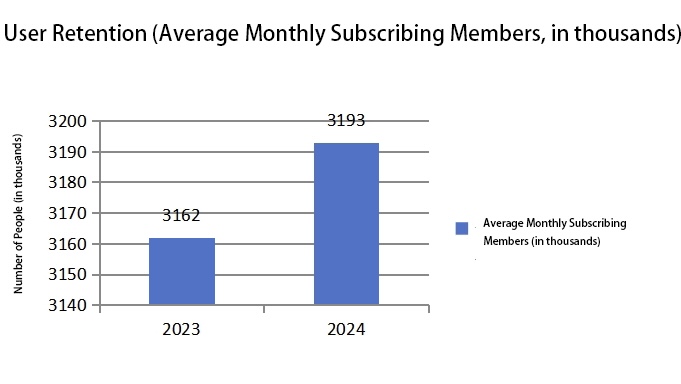
Although High satisfaction and high frequency of use mutually reinforce each other to build Keep's high user stickiness. Keep maintains a high level of user retention on the platform by constantly optimising course content, enhancing interaction experience and increasing community engagement [14]. According to the annual report data, both the membership renewal rate and the proportion of active users of the platform have maintained steady growth over the past year (Figure 4), further confirming the key role of user stickiness in the sustainable development of the platform [14].
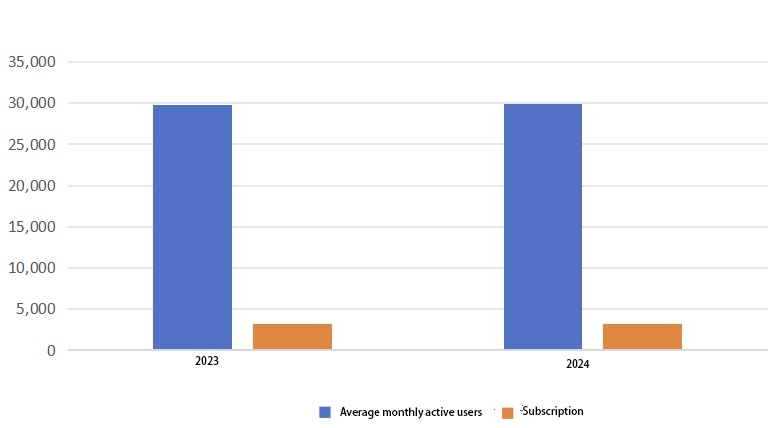
3.2. Technical operations analysis
Keep's user operations have been highly effective in precisely targeting the target group, meeting personalised needs, and enhancing user stickiness. However, efficient user operation cannot do without the support of technical means, especially in areas such as data analysis, intelligent recommendations and interaction optimisation [14-16].
Technology empowerment is one of the core supports in Keep's innovative operation model [14-16]. The platform continuously optimises intelligent training programs, course recommendations, and device interaction experiences through AI algorithms and big data technologies. Research data shows that 63.7% of users consider the smart training program "strong or very strong", with an average satisfaction score of 4.21 (out of 5) for intelligent features and device support, higher than course content (4.05) and community interaction (3.98). Based on the linear regression analysis, it was found that both user satisfaction and usage frequency were significantly positively correlated with willingness to pay (Table 2). Therefore, technology empowerment not only enhances user experience and perceived platform value, but also improves user experience, thereby driving user payment conversion and membership renewal, enhancing user retention intention and payment intention, positively achieving the conversion of technology operation to revenue for enterprises.
|
Independent variables |
Regression coefficient (β) |
Significance level (p) |
|
User satisfaction |
0.48 |
< 0.01 |
|
Frequency of use |
0.32 |
< 0.05 |
Model metrics: Adjusted R² = 0.41, F = 35.2, p < 0.01, sample size n = 182
Note: p < 0.05 indicates significance at the 95% confidence level, and p < 0.01 indicates significance at the 99% confidence level.
3.3. Ecosystem operations
Keep continues to deepen its ecosystem construction, building a complete user ecosystem through the "content + community + device" trinity model. Through data collection from smart devices and intercommunication with the platform, users' exercise behaviours are continuously tracked and analysed, which in turn feeds back to content production and personalised service recommendations, forming a data-driven positive cycle [16,17]. Analysis shows that users' willingness to participate in the service experience is positively correlated with increased willingness to use the platform(Figure 5), indicating that the stronger the interaction and service participation of users on the platform, the higher the frequency and stickiness of their use of the platform. Therefore, keep actively conducting online check-in activities, offline events and community interactions, which can enhance users' ecological participation and sense of belonging. It provides a guarantee for Keep to maintain a large user base and commercial value in the long term [16,17].
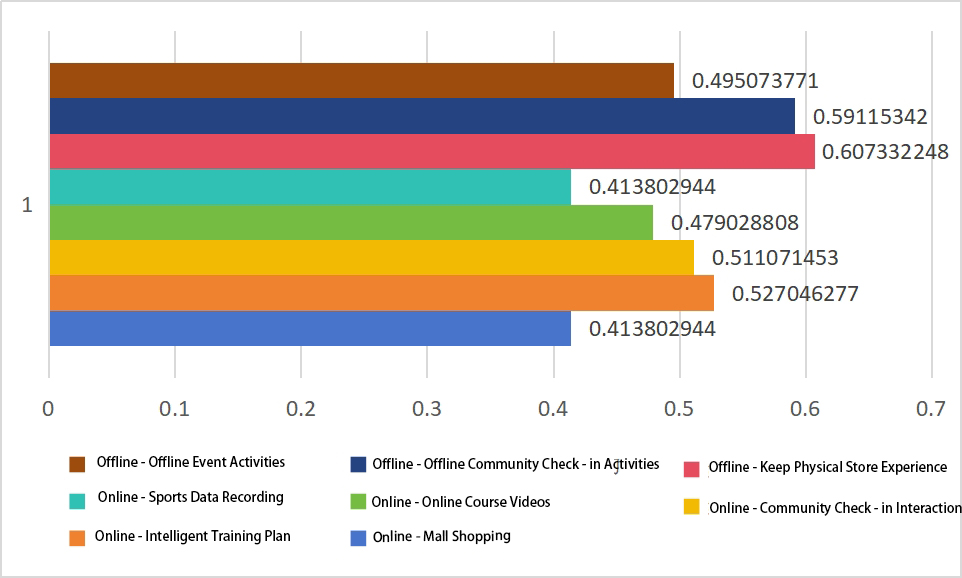
Based on the analysis of the revenue structure in Keep's annual report (Table 3), the combined revenue from its own brand sports products and membership subscriptions accounted for more than 90%, indicating that Keep has formed a diversified and stable revenue model through ecosystem operations.
|
Sources of income |
Amount (billion yuan) |
Percentage (%) |
Year-on-year change |
|
Self-owned brand sports products |
9.54 |
46.2 |
+0.8 |
|
Online membership and paid content |
9.18 |
44.4 |
-7.8 |
|
Advertising and other business revenue |
1.94 |
9.4 |
-1.0 |
4. Business innovation mechanisms and development proposals for keep fitness
4.1. User value synergy mechanism
Based on the above analysis, it is found that currently, Keep's user operation relies on online data analysis to achieve personalised recommendations and precise reach, thereby significantly increasing the lifetime value of users. At the same time, Keep achieves user value synergy through diversified content and precise user operation strategies [17]. However, efficient user value synergy requires a high degree of personalisation, and currently, Keep has a certain degree of market homogeneity in the development of this service [17]. It is suggested to enhance the "uniqueness" of the product by introducing diversified interactive activities, expanding content in vertical segments, and combining user interest tags, etc., to improve user value synergy, help users smoothly transition from interest cultivation to payment behavior, and at the same time reduce the risk of user churn caused by market homogeneity [17].
4.2. Technology enablement mechanism
Based on the current technology operation mode of Keep, it can be found that Keep's technology-driven model is more conducive to forming large-scale and sustainable profit paths, helping enterprises achieve personalised and precise recommendations, dynamically adjust training plans, optimise the interconnection between hardware and platforms, and enhance the supporting role of data analysis for operational decisions [18]. At the same time, there will be a significant increase in enterprise costs under the technology-driven mechanism, so it is necessary to rationalise the input-output ratio to ensure revenue stability [18]. In addition, safeguards should be strengthened in terms of technology and data security, and a sound data encryption, access control and user privacy protection mechanism should be established to enhance users' trust in the platform [18].
4.3. Evolution mechanism of the platform ecosystem
Keep's "trinity" ecosystem enables user connection and value extension across scenarios and terminals on a larger scale [19,20]. By building its complete data platform to interconnect online, hardware and offline Spaces for data management, to understand users' exercise preferences through data, to continuously improve products and provide corresponding services based on users' needs, and to establish a "user profile" system to provide intelligent and integrated services to users [19,20]. However, it should be noted that the ecological structure is prone to formalisation, challenging the "uniqueness" of the enterprise and making it easy to be replaced by other formalised enterprises [19,20]. Therefore, in the process of developing ecological construction, enterprises should also focus on creating brand "uniqueness" to reduce the risk of homogeneous competition [19,20].
5. Conclusions
This paper takes Keep Fitness as the research object, combining the financial data of Keep Fitness with the results of questionnaire surveys, and explores how, under the O2O business model, the diverse and innovative operational mechanisms of Internet fitness platforms can help them better retain users and increase market share. The study found that user value synergy, technology empowerment and ecosystem evolution are key factors driving business model innovation, and intelligent training programs and device functions effectively enhance user experience and payment conversion. However, technological innovation and ecosystem building also need to pay attention to the balance between cost and revenue to avoid sharp fluctuations in business operations. Future research will expand the sample of Internet fitness enterprises and combine multi-platform and multi-year data to enhance the universality of the conclusions, further analyse the causal relationship between user behaviour, technology empowerment and enterprise performance, and provide theoretical support for the sustainable development of the fitness industry.
References
[1]. Li, L. Y., and Lee, L. Y. (2022). Factors affecting consumer behaviour in omni-channel marketing of the fitness industry: motivation and attitude towards O2O channels. Journal of Cases on Information Technology (JCIT), 24(1), 1-10.
[2]. Zhang Qian. (2016). The impact of APP on the sports and fitness industry under the Internet O2O mode. Western Leather, 38 (24), 100.
[3]. Kang, D., & Kim, S. (2018). The effects of O2O service factors on sequel service adoption: O2O service quality dimensions and perceived fit.
[4]. Hsu, C. L., & Lin, J. C. C. (2020). Understanding continuance intention to use online to offline (O2O) apps. Electronic Markets, 30(4), 883-897.
[5]. Yu, L. (2020). RETRACTED ARTICLE: A novel E-commerce model and system based on O2O sports community. Information Systems and e-Business Management, 18(4), 557-577.
[6]. Chen, C. C., Hsiao, K. L., and Hsieh, C. H. (2019). Understanding usage transfer behavior of two way O2O services. Computers in Human Behavior, 100, 184-191.
[7]. MYUNG, J. D., and KIM, B. Y. (2022). Effects of medical O2O platform quality components on continuous use intention to information distribution. Journal of Distribution Science, 20(10), 105-117.
[8]. Wu, A. (2022). Big data boosts the development of china fitness industry-take keep app as an example. In 2022 2nd International Conference on Economic Development and Business Culture (ICEDBC 2022), Atlantis Press, 984-988.
[9]. Zhong, W., Quan-An, G., Zhi-Chao, M., and Chuan, Z. (2016). Study on ontology model of sports products after-sale O2O service. In 2016 International Conference on Industrial Informatics-Computing Technology, Intelligent Technology, Industrial Information Integration (ICIICII) , IEEE, 57-60.
[10]. Zhang, K., Yang, T., Liu, Z., Yi, C., Hou, Y., and Wu, T. (2025). Effects and functional mechanisms of digital fitness platforms on online fitness payment behavior under the perspective of “She-economy”. PloS one, 20(3), e0319246.
[11]. Wang, H., Muangmee, C., Meekaewkunchorn, N., Cao, H., and Sattabut, T. (2022). Evaluating the Marketing Strategy of Sports and Fitness Enterprises based on 4C Marketing Theory. In Proceedings of the 4th International Conference on Management Science and Industrial Engineering, 29-37.
[12]. Wu, B., Luo, P., Li, M., and Hu, X. (2022). The impact of health information privacy concerns on engagement and payment behaviors in online health communities. Frontiers in psychology, 13, 861903.
[13]. Yang, R., and Yu, X. (2017). Research on way of evaluating cloud end user behavior's credibility based on the methodology of multilevel fuzzy comprehensive evaluation. In Proceedings of the 6th International Conference on Software and Computer Applications, 165-170.
[14]. Lian, N., Chen, Y., and Wang, X. (2024). A study on the impact of cultural IP image on advertising communication: A case study of Bing Dwen Dwen. Media and Communication Research, 5(2), 38-45.
[15]. He, M. (2023). The Integrated High-Quality Development of Sports Undertakings in Shandong Peninsula Urban Agglomeration. In Proceedings of The 7th International Conference on Contemporary Education, Social Sciences and Humanities (Philosophy of Being Human as the Core of Interdisciplinary Research)(ICCESSH 2022), Springer Nature, 694, 306.
[16]. Li, W., Zhang, Q., Wang, X., Liu, H., and Zhang, Z. (2022). Research on the Construction of Training Mechanism of Talents with Sports Plus Wealth Management Characteristics. In The 7th International Conference on Contemporary Education, Social Sciences and Humanities (Philosophy of Being Human as the Core of Interdisciplinary Research)(ICCESSH 2022), Atlantis Press, 274-282.
[17]. Liu, Y., Li, T., and Gao, Y. (2025). Sustainable Decision Systems in Green E-Business Models: Pricing and Channel Strategies in Low-Carbon O2O Supply Chains. Sustainability (2071-1050), 17(13).
[18]. ZHOU Ting. (2023). Research on the optimization of O2O operation management mode of L smart fitness supermarket(Master thesis, Northwest A& F University).Master. Retrieved fromhttps: //link.cnki.net/doi/10.27409/d.cnki.gxbnu.2023.002746 doi: 10.27409/d.cnki.gxbnu.2023.002746.
[19]. Feng Shanshan. (2016). Randian Fitness: Using the Sharing Economy as a Private Trainer O2O. Chief Financial Officer, (13), 44-46.
[20]. Keep Inc.(2024). 2024 Annual Report. China: Keep Inc.
Cite this article
Liu,H. (2025). The Research on the Business Model Innovation Mechanism of Internet Fitness Platforms-Taking Keep Fitness as an Example. Advances in Economics, Management and Political Sciences,220,1-10.
Data availability
The datasets used and/or analyzed during the current study will be available from the authors upon reasonable request.
Disclaimer/Publisher's Note
The statements, opinions and data contained in all publications are solely those of the individual author(s) and contributor(s) and not of EWA Publishing and/or the editor(s). EWA Publishing and/or the editor(s) disclaim responsibility for any injury to people or property resulting from any ideas, methods, instructions or products referred to in the content.
About volume
Volume title: Proceedings of ICFTBA 2025 Symposium: Data-Driven Decision Making in Business and Economics
© 2024 by the author(s). Licensee EWA Publishing, Oxford, UK. This article is an open access article distributed under the terms and
conditions of the Creative Commons Attribution (CC BY) license. Authors who
publish this series agree to the following terms:
1. Authors retain copyright and grant the series right of first publication with the work simultaneously licensed under a Creative Commons
Attribution License that allows others to share the work with an acknowledgment of the work's authorship and initial publication in this
series.
2. Authors are able to enter into separate, additional contractual arrangements for the non-exclusive distribution of the series's published
version of the work (e.g., post it to an institutional repository or publish it in a book), with an acknowledgment of its initial
publication in this series.
3. Authors are permitted and encouraged to post their work online (e.g., in institutional repositories or on their website) prior to and
during the submission process, as it can lead to productive exchanges, as well as earlier and greater citation of published work (See
Open access policy for details).
References
[1]. Li, L. Y., and Lee, L. Y. (2022). Factors affecting consumer behaviour in omni-channel marketing of the fitness industry: motivation and attitude towards O2O channels. Journal of Cases on Information Technology (JCIT), 24(1), 1-10.
[2]. Zhang Qian. (2016). The impact of APP on the sports and fitness industry under the Internet O2O mode. Western Leather, 38 (24), 100.
[3]. Kang, D., & Kim, S. (2018). The effects of O2O service factors on sequel service adoption: O2O service quality dimensions and perceived fit.
[4]. Hsu, C. L., & Lin, J. C. C. (2020). Understanding continuance intention to use online to offline (O2O) apps. Electronic Markets, 30(4), 883-897.
[5]. Yu, L. (2020). RETRACTED ARTICLE: A novel E-commerce model and system based on O2O sports community. Information Systems and e-Business Management, 18(4), 557-577.
[6]. Chen, C. C., Hsiao, K. L., and Hsieh, C. H. (2019). Understanding usage transfer behavior of two way O2O services. Computers in Human Behavior, 100, 184-191.
[7]. MYUNG, J. D., and KIM, B. Y. (2022). Effects of medical O2O platform quality components on continuous use intention to information distribution. Journal of Distribution Science, 20(10), 105-117.
[8]. Wu, A. (2022). Big data boosts the development of china fitness industry-take keep app as an example. In 2022 2nd International Conference on Economic Development and Business Culture (ICEDBC 2022), Atlantis Press, 984-988.
[9]. Zhong, W., Quan-An, G., Zhi-Chao, M., and Chuan, Z. (2016). Study on ontology model of sports products after-sale O2O service. In 2016 International Conference on Industrial Informatics-Computing Technology, Intelligent Technology, Industrial Information Integration (ICIICII) , IEEE, 57-60.
[10]. Zhang, K., Yang, T., Liu, Z., Yi, C., Hou, Y., and Wu, T. (2025). Effects and functional mechanisms of digital fitness platforms on online fitness payment behavior under the perspective of “She-economy”. PloS one, 20(3), e0319246.
[11]. Wang, H., Muangmee, C., Meekaewkunchorn, N., Cao, H., and Sattabut, T. (2022). Evaluating the Marketing Strategy of Sports and Fitness Enterprises based on 4C Marketing Theory. In Proceedings of the 4th International Conference on Management Science and Industrial Engineering, 29-37.
[12]. Wu, B., Luo, P., Li, M., and Hu, X. (2022). The impact of health information privacy concerns on engagement and payment behaviors in online health communities. Frontiers in psychology, 13, 861903.
[13]. Yang, R., and Yu, X. (2017). Research on way of evaluating cloud end user behavior's credibility based on the methodology of multilevel fuzzy comprehensive evaluation. In Proceedings of the 6th International Conference on Software and Computer Applications, 165-170.
[14]. Lian, N., Chen, Y., and Wang, X. (2024). A study on the impact of cultural IP image on advertising communication: A case study of Bing Dwen Dwen. Media and Communication Research, 5(2), 38-45.
[15]. He, M. (2023). The Integrated High-Quality Development of Sports Undertakings in Shandong Peninsula Urban Agglomeration. In Proceedings of The 7th International Conference on Contemporary Education, Social Sciences and Humanities (Philosophy of Being Human as the Core of Interdisciplinary Research)(ICCESSH 2022), Springer Nature, 694, 306.
[16]. Li, W., Zhang, Q., Wang, X., Liu, H., and Zhang, Z. (2022). Research on the Construction of Training Mechanism of Talents with Sports Plus Wealth Management Characteristics. In The 7th International Conference on Contemporary Education, Social Sciences and Humanities (Philosophy of Being Human as the Core of Interdisciplinary Research)(ICCESSH 2022), Atlantis Press, 274-282.
[17]. Liu, Y., Li, T., and Gao, Y. (2025). Sustainable Decision Systems in Green E-Business Models: Pricing and Channel Strategies in Low-Carbon O2O Supply Chains. Sustainability (2071-1050), 17(13).
[18]. ZHOU Ting. (2023). Research on the optimization of O2O operation management mode of L smart fitness supermarket(Master thesis, Northwest A& F University).Master. Retrieved fromhttps: //link.cnki.net/doi/10.27409/d.cnki.gxbnu.2023.002746 doi: 10.27409/d.cnki.gxbnu.2023.002746.
[19]. Feng Shanshan. (2016). Randian Fitness: Using the Sharing Economy as a Private Trainer O2O. Chief Financial Officer, (13), 44-46.
[20]. Keep Inc.(2024). 2024 Annual Report. China: Keep Inc.









